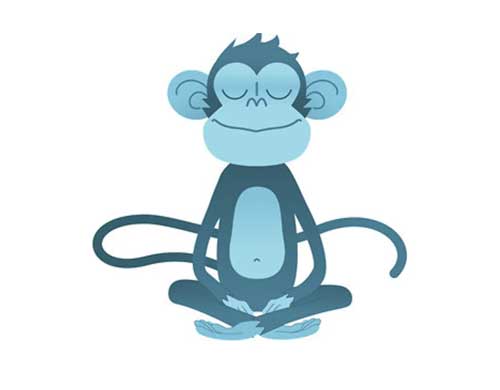What is mindfulness?
Mindfulness is the ability to stay in the present moment, paying attention to what we’re doing while also being aware of what’s happening around us in a non-judgemental way.
Training in mindfulness
This Buddhist technique of mindfulness has attracted much interest from modern scientific fields, such as psychotherapy, cognitive behaviour therapy, and sports training.
Training in mindfulness is generally delivered through written and oral instruction then experienced in mindfulness meditation. The training covers topics like antidotes to distraction, settling the restless mind and body, and overcoming boredom. The training may be delivered in varying ways, such as weekend courses, sessions with a trained psychologist, or 10-day retreats.
From a Buddhist perspective, the first stage is traditionally covered in a 10-day mindfulness retreat, or sometimes through 1.5 or 2 hour sessions over an 8 week period. I have personally completed two 10-day retreats in Calm Abiding Meditation as well as a 3-day Calm Abiding teacher training course under the guidance of Lama Choedak Rinpoche.
Lama Choedak was born on a Tibetan plateau in 1954. His family fled the Chinese Red Army invasion of their homeland to eventually re-establish their lives as refugees in Pokhara, Nepal, where they have remained. Lama Choedak completed twelve years of rigorous monastic training under Choegye Trichen’s guidance, including a traditional three-and-a-half-year solitary meditation retreat, which was sponsored by His Holiness, the Dalai Lama.
Practicing mindfulness
“Easy to learn, a lifetime to master”
Mindfulness in everyday life means being fully engaged in everything we do, say, feel, think, and see, with awareness and non-judgement. This part of the journey will take this lifetime and probably many more!
This quote from Thich Nhat Hanh sums mindfulness up nicely:
“Mindfulness is the energy of being aware and awake to the present moment. It is the continuous practice of touching life deeply in every moment of daily life. To be mindful is to be truly alive, present and at one with those around you and with what you are doing. We bring our body and mind into harmony while we wash the dishes, drive the car or take our morning shower.”
However, the Australian Psychological Society (and others) have some concerns.
“The review paper investigated conceptual, methodological and clinical implications of mindfulness research published between 1970 and 2015. Conclusions drawn indicate that mindfulness research is fraught with methodological problems and in particular, there is a lack of standardisation in how mindfulness is defined, measured and applied.”
Is mindfulness important?
With respect for modern science, if we are to live a truly engaged and meaningful life, mindfulness is very important.
Mindfulness is often used as part of treatment for anxiety, depression and general mental health wellness, however this is not the intention of the Buddha’s original teachings. Calm Abiding Meditation is an integral part of the eight-fold noble path of Buddhism and used to resolve all the afflictions and sufferings of mankind, it is not a science, nor do we need science to substantiate Buddha’s authentic teachings.
Mindfulness in the modern era has been taken out of context and is only a small portion of what Calm Abiding Meditation is about. Having said this, if we can develop a general understanding of mindfulness and Calm Abiding Meditation and use it to fully engage with life, over time life will become more fluid and flowing and the obstacles life throws at us will not seem so insurmountable.
Let’s bring this back to basics
How many times have you been on a long road trip and ended up at your destination not remembering the last couple of small towns you passed through? Or set out to complete a task only to have your mind wander off, or become distracted by almost anything except the task you set out to complete? This is referred to as the monkey mind – like an inquisitive puppy distracted by every smell, sound, and object, with no direction. Slowly over time, with meditation as a tool, we learn to gently gain control over the monkey mind.
Calm Abiding Meditation is not about ‘blissing out’. In Lama Choedak’s book, he describes the Buddha’s Four Foundations of Mindfulness, with each level becoming more subtle:
- Mindfulness of Body
- Mindfulness of Feeling
- Mindfulness of Thought
- Mindfulness of Phenomena
Meditation and mindfulness are about developing calm and clarity in life and are a form of active peace. During this practice we are not going to astral travel, obtain instant enlightenment, or spirit off to another world. To master this form of mindfulness we need to be engaged in the practice of meditation on a regular basis and focus attention on the acts of doing, knowing, seeing, and feeling in daily life.
To practice Calm Abiding Meditation is to gently watch and calm our thoughts and emotions with an attitude of gentleness and kindness towards ourselves, thus developing the clarity of undivided attention and expressing ourselves with calmness, clarity and compassion, rather than hasty uncontrolled anger or frustrated confusion.
Is this sort of meditation just a Buddhist thing?
Religious or political beliefs have nothing to do with mindfulness. This practice is a non-judgemental practice to be used by anyone, it is often linked back to Buddhism, as it was the Buddha that first taught calm abiding meditation.
Sources
- Australian Psychological Association – www.psychology.org.au/for-members/publications/inpsych/2018/feb/Being-mindful-of-mindfulness
- Mind the Hype: A Critical Evaluation and Prescriptive Agenda for Research on Mindfulness and Meditation. Perspectives on Psychological Science 13 (1): 36-61 – www.ncbi.nlm.nih.gov/pubmed/29016274
- How do mindfulness-based cognitive therapy and mindfulness-based stress reduction improve mental health and wellbeing? A systematic review and meta-analysis of mediation studies. Clinical Psychology Review 37 (37): 1-12 – www.ncbi.nlm.nih.gov/pubmed/25689576
- Taming the Elephant Mind by Lama Choedak Rinpoche – www.sakya.com.au/taming-elephant-mind-ebook
- Tibetan Buddhist Society of Canberra – www.sakya.com.au/lama-choedak-rinpoche





